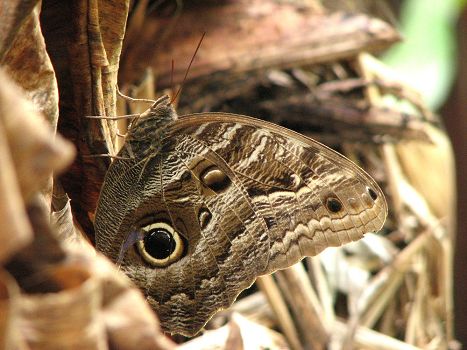
Caligo oileus (Caligo oileus)
Phylum — arthropoda
Class — insecta
Order — lepidoptera
Family — nymphalidae
Genus – caligo
Appearance
The younger caterpillars are green, the older ones are brown with six long outgrowths on the back. There are 8 horns on the head. The caterpillars are covered with short hairs. They have a short double "tail".
The wingspan of this butterfly is 10-14 cm. The upperside of the forewings is yellowish-grey, the hindwings are bluish-grey. There is one large and one small eyespots on the underside of the hind wings.
Habitat
Caligo oileus occurs from Panama to Bolivia.
Behavior
Butterflies Caligo oileus are usually encountered as singletons, flying just before dusk along narrow trails. They are strongly attracted to rotting plantain and other fruit on the forest floor. If alarmed they fly off in an ungainly fashion, with the flapping of their wings clearly audible. Normally they fly only a few meters at a time, and settle on tree trunks, but if they attempt to land on foliage they often fail to maintain their grip, and are forced to fly off again and settle elsewhere.
They continue flying throughout the night, and are often attracted into buildings by artificial lighting. Just before dawn they seek out narrow tree trunks, on which they roost during daylight hours at a height of between 1-2 meters above ground level. On particularly dull and damp mornings they will continue flying, sometimes in quite open areas along the edge of forest roads.
The larvae are gregarious. The larvae are nocturnal, and rest during daylight hours on dead leaves at the base of the foodplants, where they are superbly camouflaged.
Diet
The larvae feed on Heliconia and Musa species.
Reproduction
For their reproduction you need a terrarium with a size of 70 x 70 x 90 cm at the temperature of 22-24 °C. Females lay eggs in groups of 20 or more on the leaves of the forage plant. Eggs are white and round. The incubation period is 3-5 days. Caterpillars from the same group hatch at the same time and try to stick together. During the day they sit on dry leaves at the base of the forage plant and they feed at night. The temperature for keeping is 22-24 °C and humidity is 65-80%. It is better not to transplant caterpillars from one plant to another and put them in a terrarium pot with a plant. The caterpillar develops for 30-50 days. The large stocky pupa is pale brown with darker streaks and closely resembles a bit of dead foliage. It is formed hanging by the cremaster from woody stems or amongst clumps of dead leaves. The pupa develops for 2-3 weeks. Adult butterflies live up to 2 months.
In captivity
The mesh terrarium with a size of 50 × 50 × 70 mm is suitable for keeping butterflies. Room temperature is necessary. Daylight time is 12 hours. You can feed the butterflies with an overripe banana, orange, pineapple, mango, or give them a few drops of honey syrup diluted with boiled water in a ratio of 1:10. You can give them a mixture of overripe banana, yogurt and orange juice.
 Russian
Russian
 English
English























